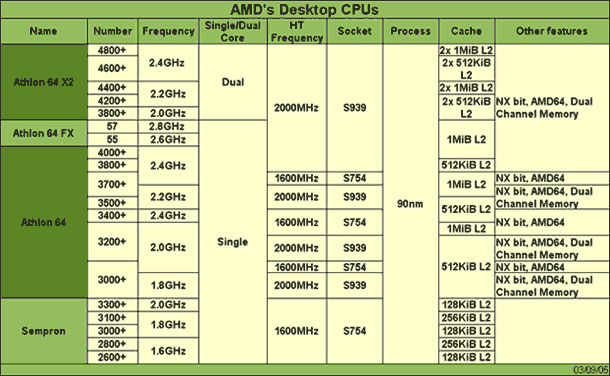Our Aim
To provide you with an overview on New And existing technologies, hopefully helping you understand the changes in the technology. Together with the overviews we hope to bring topical issues to light from a series of independent reviewers saving you the time And hassle of fact finding over the web.
We will over time provide you with quality content which you can browse and subscribe to at your leisure.
TekSpek 's

CPU Codes
Date issued:
AMD
Processors by AMD continue to use the same performance
rating system that compares them to the old style clock speed product
names of Intel processors. AMD's performance ratings do at first
seem simpler, but the actual product features underlying the rating
numbers can vary in a confusing way. Better still, AMD's Opteron
chips use a numbering system similar to Intel's, although given
that it isn't used on quite as many products, it's a little easier
to understand. However, we're going to stick with desktop CPUs for
now.
There are currently two main desktop product ranges made by AMD, Athlon 64 and Sempron. The PR system started life with the older 32-bit Athlons and continues to be used with AMD's latest 64-bit Athlons
Where the four figure PR number is used, it tends to signify performance
equivalent to the MHz clock of an Intel counterpart, with a '+'
at the end of the product number to hint that the performance is
in fact greater. So, the higher the number, the higher the performance.
Alas, clock speed isn't the only thing that influences product number.
This becomes clear in the following table.

If you're a multi-tasker, sitting at the top of AMD's performance ladder is the X2 processor, AMD's dual core desktop offering. Currently, you'll find five X2 processors, but only three different clock speeds. The 4800+ and 4600+ share a 2.4GHz clock speed and the 4400+ and 4200+ both run at 2.2GHz. The 3800+ clocks in at 2.0GHz, and you can bet if there was a 4000+, it'd share the 3800+'s clock speed.
So, how are these pairs of processors different from each other? The answer lies in the cache. 4400+ and 4800+ have 2x 1MiB of L2 cache, while the others have 2x 512KiB of L2 cache. More cache leads to higher performance (depending on what applications you're running.)
All X2 processors are Socket 939, meaning they have dual channel RAM support, along with AMD64 and NX bit technology.
Athlon 64 FX
More of a gamer than a multi-tasker? Then the Athlon 64 FX will sit atop your performance ladder. There are two current Athlon 64 FX processors and they have the FX-57 and FX-55. Both have 1MiB L2 cache and the same features as other Socket 939 processors from AMD. The 55 runs at 2.6GHz, the 57 at 2.8GHz. Pretty simple.
Athlon 64
Moving on to the 'regular' Athlon 64, there are shared model numbers to make things that little bit more interesting. If you are looking purely at the latest range of Athlon 64 processors, which is what we're doing here, then the difference lies primarily in the socket used. For example, you can get a 3700+ for Socket 939, or for Socket 754. The 754 variant supports single channel memory and has an HT (Hyper Transport) frequency of 1600MHz, whereas the 939 version supports dual channel memory and a 2000MHz HT clock. All models sport AMD64 and NX bit support.
Again, as with the X2 range, some processor models, even on the same socket, share the same clock speed, but have different model numbers. Again, it's a case of cache. The 2.4GHz 3800+ has 512KiB of L2, while the 2.4GHz 4000+ has a princely 1MiB.
When you're looking at Athlon 64 processors, decide which socket type you want first, then it's easier to compare the processors just for that socket.
Sempron
AMD's answer to the Celeron is the Sempron processor. It is available for socket 754 or the older socket A type motherboard, however socket A is is being phased out so we'll ignore it henceforth. All socket 754 Semprons have single channel memory support and a 1600MHz HT clock. Just like we've seen from other AMD products, some models share the same clock speed, but have larger caches. In this case it's either 128KiB or 256KiB.

